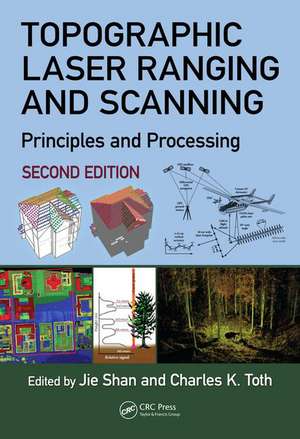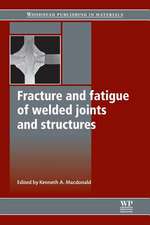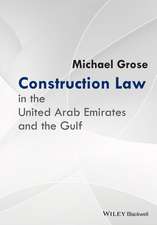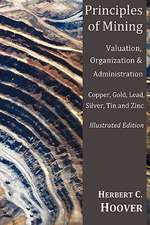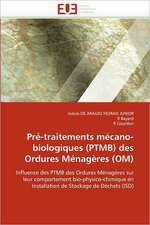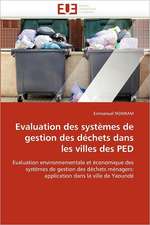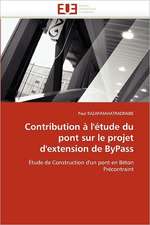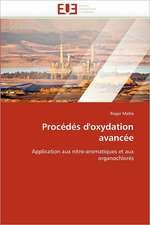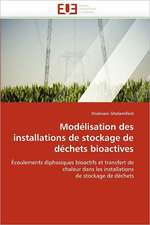Topographic Laser Ranging and Scanning: Principles and Processing, Second Edition
Editat de Jie Shan, Charles K. Tothen Limba Engleză Hardback – 5 mar 2018
Written by leaders in the field, this comprehensive compilation is a must-have reference book for senior undergraduate and graduate students majoring or working in diverse disciplines, such as geomatics, geodesy, natural resources, urban planning, computer vision, and computer graphics. It is also vital resource for researchers who are interested in developing new methods and need in-depth knowledge of laser scanning and data processing and other professionals may gain the same from the broad topics addressed in this book.
New in the Second Edition:
- A comprehensive array of new laser ranging and scanning technologies.
- Developments in LiDAR data format and processing techniques.
- Regrouping of surface modeling, representations and reconstruction.
- Enhanced discussions on the principles and fundamentals beyond small-footprint pulsed laser systems and new application examples.
- Many new examples and illustrations.
| Toate formatele și edițiile | Preț | Express |
|---|---|---|
| Paperback (1) | 352.40 lei 3-5 săpt. | +62.14 lei 5-11 zile |
| CRC Press – 21 ian 2023 | 352.40 lei 3-5 săpt. | +62.14 lei 5-11 zile |
| Hardback (1) | 1596.07 lei 6-8 săpt. | |
| CRC Press – 5 mar 2018 | 1596.07 lei 6-8 săpt. |
Preț: 1596.07 lei
Preț vechi: 1946.43 lei
-18% Nou
Puncte Express: 2394
Preț estimativ în valută:
305.50€ • 331.96$ • 256.79£
305.50€ • 331.96$ • 256.79£
Carte tipărită la comandă
Livrare economică 21 aprilie-05 mai
Preluare comenzi: 021 569.72.76
Specificații
ISBN-13: 9781498772273
ISBN-10: 1498772277
Pagini: 654
Ilustrații: 97 Illustrations, color; 459 Illustrations, black and white
Dimensiuni: 178 x 254 x 43 mm
Greutate: 1.93 kg
Ediția:2nd edition
Editura: CRC Press
Colecția CRC Press
ISBN-10: 1498772277
Pagini: 654
Ilustrații: 97 Illustrations, color; 459 Illustrations, black and white
Dimensiuni: 178 x 254 x 43 mm
Greutate: 1.93 kg
Ediția:2nd edition
Editura: CRC Press
Colecția CRC Press
Public țintă
Professional Practice & DevelopmentCuprins
Preface to the Second Edition. Preface to the First Edition. Editors. Contributors. Introduction to Laser Ranging, Profiling, and Scanning. Terrestrial Laser Scanners. Airborne and Spaceborne Laser Profilers and Scanners.LiDAR Systems and Calibration. Pulsed Laser Altimeter Ranging Techniques and Implications for Terrain Mapping. Georeferencing Component of LiDAR Systems. Full-Waveform Analysis for Pulsed Laser Systems. Strip Adjustment. Accuracy, Quality Assurance, and Quality Control of Light Detection and Ranging Mapping. Data Management of Light Detection and Ranging. LiDAR Data Filtering and Digital Terrain Model Generation. Forest Inventory Using Laser Scanning. Integration of LiDAR and Photogrammetric Data: Triangulation and Orthorectification. Feature Extraction from Light Detection and Ranging Data in Urban Areas. Global Solutions to Building Segmentation and Reconstruction. Building and Road Extraction from LiDAR Data. Progressive Modeling of 3D Building Rooftops from Airborne LiDAR and Imagery. A Framework for Automated Construction of Building Models from Airborne LiDAR Measurements. Quality of Buildings Extracted from Airborne Laser Scanning Data—Results of an Empirical Investigation on 3D Building Reconstruction. Index.
Recenzii
"This book is a must-have resource for students, educators and users of LiDAR data. Comprehensive in scope and newly updated, the book is a key reference for all aspects of LiDAR. This masterful compilation, written by the leaders in the field, captures the latest developments in the rapidly growing field of laser ranging and scanning."
—Timothy A. Warner, West Virginia University, USA
"With the significant recent developments in LiDAR technology, such as single-photon and Geiger-mode LiDAR, the publication of this substantially updated Second Edition is a welcome addition to the geomatics literature. Descriptions of applications have been expanded to cover recent technological developments such as integrated mobile mapping systems and sensors mounted upon unmanned aerial systems, with there also being expanded coverage of automated feature extraction, 3D building extraction and modelling, and the application of LiDAR for forest inventory and management. The comprehensiveness of this book makes it an ideal textbook, as well as a valuable reference source for university students, researchers and practitioners of LiDAR technology."
—Clive S. Fraser, University of Melbourne, Australia
"There are few in-depth references on this important source of geospatial data, and this text fills an important void. While one can find many articles in scientific journals, there is no comprehensive treatment of the subject equal to that found in this book. It will be a seminal resource for new professionals entering the field and for seasoned professionals seeking to keep their knowledge current. As a remote sensing educator at a leading university, I consider this publication to be an essential addition to the library of any serious student or practitioner in the geospatial field."
—Karen Schuckman, Pennsylvania State University, USA
"This second edition of Topographic Laser Ranging and Scanning (2009) arrives none too soon, as the pace of innovation and accelerated use of LiDAR instruments has rapidly expanded into new applications areas. The nine chapters, written by recognized leaders in the field, covers a full range of Lidar systems, including strategic revisions and updates to accommodate new applications and capabilities. This volume, like its predecessor, provides ample graphics, carefully tailored to clearly illustrate key concepts presented by the text. This edition is valuable as an authoritative text, assessable to students, but also as an important reference for practitioners, scientists, and faculty. It is effectively organized, concise, and clearly presented with ample references, forming a valuable asset to prepare analysts in all aspects of Lidar systems."
—James B. Campbell, Virginia Polytechnic Institute and State University, Blacksburg, Virginia, USA
"Since the publication of the 1st edition, this book is one of top LiDAR references for research and teaching. Thus, the 2nd edition is highly welcomed to keep its readers and followers updated with the most recent technologies in this fascinating field. …the book gives an excellent overview of the state-of-the art of data collection and data processing. It is recommended to all students, academics and practitioners dealing with LiDAR technologies and its applications."
— Dieter Fritsch, University of Stuttgart, Germany
"This second edition of the book offers comprehensive coverage of principles, technology and applications, like its predecessor. About half of the 19 chapters have been amply expanded and improved to cover recent developments like lidars based on single-photon avalanche detectors (SPADs), integrated mobile mapping, 3-D measurements on buildings, developments of lidar data processing techniques, and remote sensing of forest inventory."
— Silvano Donati, University of Pavia, Italy
—Timothy A. Warner, West Virginia University, USA
"With the significant recent developments in LiDAR technology, such as single-photon and Geiger-mode LiDAR, the publication of this substantially updated Second Edition is a welcome addition to the geomatics literature. Descriptions of applications have been expanded to cover recent technological developments such as integrated mobile mapping systems and sensors mounted upon unmanned aerial systems, with there also being expanded coverage of automated feature extraction, 3D building extraction and modelling, and the application of LiDAR for forest inventory and management. The comprehensiveness of this book makes it an ideal textbook, as well as a valuable reference source for university students, researchers and practitioners of LiDAR technology."
—Clive S. Fraser, University of Melbourne, Australia
"There are few in-depth references on this important source of geospatial data, and this text fills an important void. While one can find many articles in scientific journals, there is no comprehensive treatment of the subject equal to that found in this book. It will be a seminal resource for new professionals entering the field and for seasoned professionals seeking to keep their knowledge current. As a remote sensing educator at a leading university, I consider this publication to be an essential addition to the library of any serious student or practitioner in the geospatial field."
—Karen Schuckman, Pennsylvania State University, USA
"This second edition of Topographic Laser Ranging and Scanning (2009) arrives none too soon, as the pace of innovation and accelerated use of LiDAR instruments has rapidly expanded into new applications areas. The nine chapters, written by recognized leaders in the field, covers a full range of Lidar systems, including strategic revisions and updates to accommodate new applications and capabilities. This volume, like its predecessor, provides ample graphics, carefully tailored to clearly illustrate key concepts presented by the text. This edition is valuable as an authoritative text, assessable to students, but also as an important reference for practitioners, scientists, and faculty. It is effectively organized, concise, and clearly presented with ample references, forming a valuable asset to prepare analysts in all aspects of Lidar systems."
—James B. Campbell, Virginia Polytechnic Institute and State University, Blacksburg, Virginia, USA
"Since the publication of the 1st edition, this book is one of top LiDAR references for research and teaching. Thus, the 2nd edition is highly welcomed to keep its readers and followers updated with the most recent technologies in this fascinating field. …the book gives an excellent overview of the state-of-the art of data collection and data processing. It is recommended to all students, academics and practitioners dealing with LiDAR technologies and its applications."
— Dieter Fritsch, University of Stuttgart, Germany
"This second edition of the book offers comprehensive coverage of principles, technology and applications, like its predecessor. About half of the 19 chapters have been amply expanded and improved to cover recent developments like lidars based on single-photon avalanche detectors (SPADs), integrated mobile mapping, 3-D measurements on buildings, developments of lidar data processing techniques, and remote sensing of forest inventory."
— Silvano Donati, University of Pavia, Italy
Descriere
This book provides a comprehensive discussion of topographic LiDAR principles, systems, data acquisition, and data processing techniques. Ranging and scanning fundamentals, and broad, contemporary analysis of airborne LiDAR systems, as well as those situated on land and in space are covered.
Notă biografică
Jie Shan received his PhD in photogrammetry and remote sensing from Wuhan University, China. Since then he has worked as faculty at universities in China, Sweden, and the United States, and has been a research fellow in Germany. Currently, he is an associate professor in geomatics engineering at the school of Civil Engineering of Purdue University, West Lafayette, Indiana, where he teaches subjects in photogrammetry and remote sensing, and geospatial information science and technology. His research interests are digital mapping, geospatial data mining, and urban modeling. He is a recipient of multiple academic awards and author/coauthor of over 100 scientific papers.
Charles K. Toth has PhDs in electrical engineering and geoinformation science from the University of Budapest, Budapest, Hungary, and is currently a senior research scientist with the Ohio State University Center for Mapping. His research expertise covers broad areas of 2D/3D signal processing, spatial information systems, airborne imaging, surface extraction and modeling, integrating and calibrating of multisensor systems, multisensory geospatial data acquisition systems, and mobile mapping technology. His references are represented by over 150 scientific/technical papers.
Charles K. Toth has PhDs in electrical engineering and geoinformation science from the University of Budapest, Budapest, Hungary, and is currently a senior research scientist with the Ohio State University Center for Mapping. His research expertise covers broad areas of 2D/3D signal processing, spatial information systems, airborne imaging, surface extraction and modeling, integrating and calibrating of multisensor systems, multisensory geospatial data acquisition systems, and mobile mapping technology. His references are represented by over 150 scientific/technical papers.
